What is Inflation, What's Driving It,
And What Can You do About it?
-
AUTHOR
Harrison Burge -
PUBLISHED
July 8, 2021
Are you concerned about rapidly rising inflation? Are you prepared to face higher consumer prices? And is your investment portfolio prepared for the impact?
In this article, we’ll first discuss what we mean by “inflation.” We’ll delve into why 2021 is a lot like the previous inflation cycle of 2010-2011. And then we’ll discuss how you can protect yourself against it.
Interested in solutions to protect your wealth against inflation?
If so, skip straight down to the solutions section by clicking below.
Here’s how you can protect yourself against inflation.
Also be sure to view our latest article on Asset Price Inflation here.
UPDATE: The latest US Consumer Price Index numbers were released this morning. The headline number is a 5.4% YoY increase. That’s what many journalists will be running with.
But the more important, underreported number is the annualized look ahead statistic. In June, there was a 0.9% increase in all prices. Annualized, that’s 11.35%.
So, the look-ahead number is over DOUBLE the look-back number…
Please note: We are not financial advisors, and the below content is intended for informational purposes only. Consult with a trusted financial professional to determine how you can best prepare for inflation.
Money printing, aka quantitative easing (QE), as we have seen in the US and elsewhere since the COVID-19 pandemic started, is a key cause of inflation.
Inflation can also be caused by rising production and/or labor costs, by an increase in the prices of raw materials, or by a surge in demand, meaning that consumers are willing to pay more for a given product or service.
However, an increase in the money supply alone is often not sufficient to cause inflation. There's a demand component, too.
When people are uncertain about the future, they tend to hoard money, not spend it.
So, with the desire to hold cash balances high, even a significant increase in the money supply may not translate into higher inflation.
But when there's more certainty about the future, people tend to more freely spend.
People will also spend more when they realize that their money buys more goods and services today than tomorrow.
Once the idea of price inflation takes hold in the mind of the consumer, the desire to hold cash decreases.
Inflation can be broken down into three primary categories:
Stagflation, which was first identified as an economic phenomenon in the 1970s, is the combination of persistently high price inflation, in combination with stagnant demand, slow economic growth, and high unemployment. Alternatively, stagflation can be defined as a drop in Gross Domestic Product (GDP), combined with a period of persistent inflation.
Consumer Price Index (CPI) is a measure used to appraise the weighted average price of a selection of consumer goods and services (referred to as a "basket of goods").
This basket typically includes items such as food, transportation costs, healthcare, etc.
The CPI is calculated by averaging out the price of the various items and service in this basket of goods. It is one of the most frequently used indicators for measuring price inflation or deflation for a particular period of time.
Food prices were surging.
Consumers were worried. Paychecks were already stretched thin.
And people wanted answers. They got one… and it was a moment that would be forever remembered.
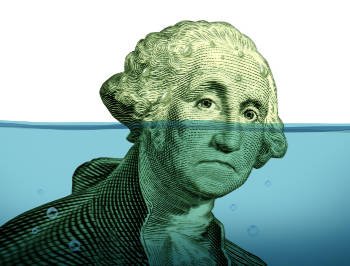
Back in March 2011, reporters and residents gathered in Queens to hear from New York Federal Reserve President Bill Dudley. An audience member asked Dudley if he had visited a grocery store recently to see the rapidly rising food prices.
Dudley tried to reassure the crowd that the Federal Reserve takes into account rising prices… but with food and energy costs stripped out.
That remark wasn’t too comforting to the crowd. But then came the doozy…
Dudley said that while food prices are rising, other prices are falling. He continued: “Today you can buy an iPad 2 that costs the same as an iPad 1 that is twice as powerful. You have to look at the prices of all things.”
A reporter from the back of the room quickly responded, “I can’t eat an iPad.”
This is now known as the famous “let them eat iPads” incident. While many people were focused on how to feed their families, central bankers were fixated on the falling prices of iPads.
Fed officials demonstrated that day truly how out of touch they were with normal people.
And over a decade later, many policymakers are still massively out of touch.
They’re devoted to their neat, tidy economic models and forecasts. They dismiss what’s actually happening in the real world.
Because in the real world, producers and consumers are again facing a rising price environment — food, energy, input costs for businesses and retail prices are all climbing. And as the cycle repeats itself, the policy response from 10 years ago may also be repeated.
How exactly do we, at Sovereign Man, think about “inflation”?
Monetary inflation. Price inflation. You’ll hear various forms of inflation discussed during this time.
Inflation is widely misunderstood as an increase in prices.
But it’s actually an increase in the money supply; as Milton Friedman quipped, “Inflation is always and everywhere a monetary phenomenon.”
In simplistic terms, inflation is too much money relative to the amount of stuff in an economy.
At any given time, an economy has a set amount of stuff, or goods and services — iPads, cars, gasoline, corn, your accountant’s services, your cryptocurrency holdings, dry cleaning for your business suits (although, that’s not needed as much these days), etc.
For this “stuff” to emerge, entrepreneurs have to go out and make things happen. They use finite resources to produce in-demand goods or services. It takes time and capital to create a business that provides value for consumers or other businesses.
But central bankers are immune from the restrictions and realities of the physical world.
Their magic money machine enables them to conjure extra currency out of thin air. (Later we’ll discuss the details of how central banks “create” new money.)
However, conjuring money doesn’t create any additional prosperity. In fact, when the Fed comes in with their giant brick of cash, it mucks up the economy. There’s more money, but the same amount of stuff.
And now, thanks to our COVID-19 overlords, lockdowns and arbitrary re-openings have resulted in even less stuff available in the economy.
Too much money printing plus even less available stuff is a recipe for higher inflation.
To truly understand what’s currently happening in the economy, we need to travel back in time to 2008-2011.
Remember, after the 2008 financial crisis, the economy was in ruins. It was an economic cataclysm.
Some banks collapsed. Some banks merged with others. Congress passed the unpopular Troubled Asset Relief Program (TARP), which initially authorized $700 billion in toxic assets and equity purchases from financial institutions.
Giant companies like General Motors received billions in bailout money.
And aside from fiscal stimulus, the Federal Reserve — the central bank of the United States — chipped in with monetary stimulus. To attempt to restart economic activity, they immediately slashed interest rates to zero.
Also, a couple months later, in November 2008, the Fed announced a new program called “Quantitative Easing” or QE, for short.
No one had ever heard of QE before. It was Fed-speak, and cover for their intentions: To create a giant tidal wave of money.
Unelected central bankers dictate short-term interest rates and steer money creation
The single most important price in an economy is the rate of interest.
Effectively, interest is the price of money.
In a pure market economy, interest rates respond to the economy’s aggregate amount of savings. (When more savings are available — because individuals have opted to defer their spending, this situation causes interest rates to fall. But when less savings are available — because individuals have opted to spend, this situation causes interest rates to rise.)
And interest rates ultimately guide the overall allocation of investment spending versus consumer spending.
If interest rates are low, that spurs entrepreneurs to borrow for new projects (which are often long-term and capital-intensive) or to expand their existing businesses. But when interest rates rise, entrepreneurs are not as willing to embark on new projects and expansions.
Again, that’s how interest rates are supposed to work and be moderated — based on the amount of savings in an economy.
But economies with central banks operate differently.
Savings are NOT in charge. No — the central bankers are in charge of setting short-term interest rates. (And when central banks engage in “Quantitative Easing,” they in part control interest rates on longer-dated securities, like the 10-year Treasury note and 30-year Treasury bond.)
That’s an enormous amount of power to give a small group. And this group does not have the best interests of the people at heart. They’re not even elected by the people.
Instead, the Federal Open Market Committee (FOMC) is composed of the Federal Reserve Chair, the President of the New York Federal Reserve Bank and four of the other 11 regional banks. These people are former investment bankers themselves, or at least, have ties to investment banks — as consultants or through academic work, for example.
So, JP Morgan and other banks get to pick the people — or have substantial influence over — who control interest rates.
Not a bad gig.
When the Fed opts to increase the money supply, you’ll hear phrases that they’re “printing money” or “papering over the problem” (the problem of too much money that they previously caused).
But those are just metaphors.
There’s no one in the basement of the New York Fed who’s running a printing press. About 90% of money is electronic and is created by adding digits to a screen.
This digit-adding activity leaves behind a paper trail, however.
Like any business, the Fed has a balance sheet. They release the latest balance sheet (the H.4.1 report) every week.
Going into the 2008 financial crisis, the Fed had about $800 billion of assets.
(As we write this, the Fed has $8 TRILLION of assets on its balance sheet.)
That $800 billion of assets consisted of US Treasury securities — mostly 10-year notes and 30-year bonds — and mortgage-backed securities (MBS).
If that term rings a bell, yes, mortgage-backed securities were the toxic assets that in part caused the 2008 financial crisis.
(As a refresher on mortgage-backed securities: After you secure a mortgage for your $500,000 house, your bank will pool that mortgage, along with dozens or more other mortgages. These mortgages are bought, sold and repackaged by banks until ultimately, they are pooled into investable bonds known as MBS.)
MBS are huge, fungible (i.e. the same) pools of capital available for large financial institutions and the Fed to trade. When you need to deploy $50 billion at a time, it’s not easy to do so in collectibles, art or fine wine. But it’s easy to quickly buy $50 billion of MBS.
So, when the Fed “prints” $50 billion of new money, what they really do is either buy government bonds or a bank’s portfolio of MBS. If the Fed buys MBS from JP Morgan, it will deposit $50 billion into JP Morgan’s reserve account. That $50 billion was conjured out of thin air.
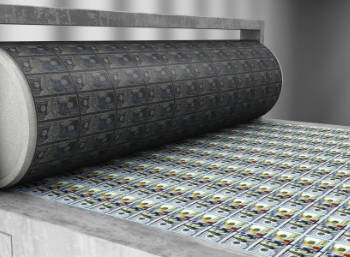
From an accounting perspective, the Fed creates $50 billion in liabilities — Federal Reserve note liabilities — to balance the new $50 billion in assets.
That’s how the Fed grows its balance sheet and increases the money supply. (Commercial banks also have a hand in the expansion of the money supply, but that’s a discussion for another day.)
The Fed then repeats this process over and over…
Between November 2008, when the Fed first announced Quantitative Easing, and mid-2010, the Fed expanded its balance sheet from $800 billion to $2.1 trillion.
And after the Fed first announced QE, the US dollar, as measured by the DXY (the US Dollar Index), started to fall against other currencies.
As the value of the dollar weakened, prices started to become more expensive for Americans in US dollar terms.
That’s because the US imports far more than it exports.
In 2008, the US goods and services trade deficit was $695.9 billion. And although the deficit dropped significantly in 2009 (as the US economy recovered from the financial crisis), it was still $380.7 billion.
With prices rapidly rising, in June 2010, the Fed announced that it would end QE.
But a few months later, in November 2010, Fed officials changed their mind. And they started a second round of Quantitative Easing, known as QE2.
QE2 lasted from late 2010 until June 2011.
Through this period, price inflation soared. The Dollar Index hit a low point post-economic recovery. And gold hit its then all-time record high of $1,900+ per ounce.
All these events happened in the first half of 2011.
Ten years later, we could be repeating a similar inflationary cycle… or potentially even worse.
Inflation is soaring.
According to the May 2021 Consumer Price Index (CPI) report, on an annualized basis, inflation is now 7.2%.
(CPI measures price changes for a basket of consumer goods.)
The US Dollar Index hit another low…
And just like in the last financial crisis, the federal government is paying people NOT to work. Except this time, the benefits are even more generous.
Still, Fed officials don’t seem to be too concerned about inflation… at least not yet.
In 2011, New York Fed President Dudley touted the falling prices of the iPad 2.
In 2021, out-of-touch Fed officials are once again repeating their mantra at every turn: Inflation is “transitory,” and it’s nothing to worry about. They insist that they will keep annual inflation at a rate of 2%.
But the Fed has almost no credibility.
Even the Biden administration assumes that inflation will be higher than the Fed’s 2% promise. See page 60 of The White House’s recently released budget report for their inflation assumptions.
The 10-year Biden Budget assumes an inflation rate that’s, proportionally, 15% higher than what the Federal Reserve promises. There’s not even a show or attempt at solidarity between the federal government and the Fed.
And if inflation were to get out of control soon — as it may very well — a further rift could develop.
There are plenty of reasons why this inflationary period could be different from the last one. Some are by design. Others are unintended consequences of 2020 and 2021 policies. Regardless, much higher inflation may well be on its way…
The last remaining holdout US states have finally reopened.
But while the majority of COVID lockdowns are a thing of the past (at least for the time being), the rules may stay with us for a while. Or if federal and state bureaucrats have their way, these rules may permanently alter business operations.
Post-COVID, businesses face a barrage of extra costs.
For example, retail establishments are now set up like nightclubs with bouncers. These businesses — which were already struggling to compete with online retailers in 2019 — now have a dedicated employee to spray down customers as they enter the store.
Also, many hotels are now forced to keep a used room vacant for 24 hours after a guest checks out to ensure “proper ventilation” before the next guest arrives.
This means that under these restrictions, a hotel can never operate at 100% capacity — in fact, with available beds in any calendar month slashed by half, the maximum occupancy rate achievable drops to only 50%. And that will cost hotels a ton of money, and raise the prices for rooms.
Manufacturing plants might continue COVID protocols. So, an employee who has not tested positive, feels great, but whose temperature is, say, 99.1 degrees Fahrenheit — rather than 98.6 degrees — could be sent home. Depending on the shift duration, the economy has lost 8 to 12 productive hours.
And besides lost hours and ongoing COVID restrictions, the economy is suffering from overall lower productive capacity…
At this point, the economic impact of 2020 is still difficult to estimate.
According to the Federal Reserve, about 200,000 US businesses permanently closed as a result of the COVID restrictions and lockdowns.
Among the companies that survived, many are plagued with worker shortages. Compounding the issue is all the free money that the government is giving to people — no one wants to go back to work.
Already struggling businesses are now forced to increase salaries and/or benefits massively, or try to make do with fewer employees. Regardless, this spells price increases for their customers.
Some companies must also contend with the new rules we noted above, while others have to deal with both issues.
So, we’ll see how many more businesses cannot stay afloat in the coming years.
Of course, there were some winners in 2020, too.
But even those businesses that thrived in 2020 — Walmart, Amazon, Home Depot, etc. — could not (and still cannot) escape the ongoing supply chain disruptions.
Add up all these issues, and clearly, the economy remains constrained. This sharp reduction in goods and services will take time to restore.
Sure, by the day, more businesses are slowly ramping up.
But let’s not get ahead of ourselves…
There’s this misplaced notion that as more businesses reopen, production will instantly return. And as production ramps up, the theory is that prices will quickly stabilize or even fall. However, turning around an economy is not like flipping a lightswitch.
Businesses cannot absorb all these additional costs from lower productivity, so they will pass on higher prices to consumers. And the Federal Reserve keeps on printing money.
So, here comes that refrain: Less available stuff plus more money equals higher inflation.
Expect higher inflation in food prices, too, for another reason…
Because the supply constraints also extend to agriculture. There’s a historic drought in the western United States. Some of California’s reservoirs are running dry, which will impact this year’s harvest.
With less domestic production, the US will need to further increase its agricultural imports.
This is at a time when US agricultural imports are already outpacing exports, in terms of percentage change. Compared to 2009 (the first full year post-financial crisis), US agricultural exports in 2020 increased by 41%. But over the same timeframe, agricultural imports increased by 81%.
And in the coming years, the US government’s tax policies could further increase ALL imports…
Breaking news: Higher taxes are likely coming.
Higher income taxes. Higher estate taxes. Higher capital gains taxes.
Maybe even a “wealth tax” — where the government taxes your unrealized capital gains. That means if you don’t have the necessary cash lying around, you may have to sell a portion of your assets each year to settle your tax bill.
Instead of capital staying in the hands of entrepreneurs, it will get siphoned into the government’s coffers… where it will be spent on billion dollar websites, and will be ripe for fraud, waste and abuse.
Higher taxes will also extend to corporations. The Biden administration aims to raise the corporate tax to 28%.
There are also calls for a 15% global minimum tax rate. You know, to cut down on so-called tax havens like Ireland (12.5% corporate tax rate), Singapore (17%) and others.
In reality, countries have a long, winding path to agree on a global minimum tax rate. Presidents and Prime Ministers cannot unilaterally change tax policy with the stroke of a pen. Legislatures need to amend tax treaties, and that will take time.
And inevitably, some countries would not get on board.
But let’s imagine that governments can pass through a 15% global minimum tax. And let’s assume that the US does hike its corporate tax rate to 28%.
Congratulations, US politicians and policymakers: You’ve just created a huge disincentive to produce in America. Why would a corporation stay in the US and pay an additional 13%? Even if Ireland agrees to the 15% minimum corporate tax rate, they would be huge beneficiaries.
Essentially, the US would “Make Ireland Great Again.” Or execute the “Ireland First” agenda.
With more production offshore, that means more US money printing to pay for these imports, which equals higher inflation. And adding fuel to the fire is the Federal Reserve’s current monetary policy…
The trend to avoid excessive taxation is well underway
Since shortly after COVID struck, a trend already in motion was suddenly supercharged…
With newfound freedom to work from home, even more people left rabid Marxist governments, lockdowns, and high tax states for freer, no-tax states like Florida and Texas.
We also see this happening in Puerto Rico, where some members of Sovereign Man reside.
Puerto Rico offers amazing tax incentives: a 4% corporate tax rate and 0% on dividends and capital gains. For more details, click here.
In a healthy, productive economy, there is ample savings.
A high rate of savings enables entrepreneurs to expand their businesses and produce more. Consumers benefit in the future from these additional goods and services. And, all else being equal, prices tend to decline.
In other words, market economies result in deflation.
But we don’t have a true market economy. We have central bankers who regularly inject their monetary methamphetamine into the economy, thereby creating inflation. (Again, too much money chasing too little stuff.)
There’s a reason why the Fed and other central bankers constantly keep their foot on the money printing gas: They’re terrified of deflation, and view it as a death spiral. The logic is that in a deflationary environment, people won’t spend money. Instead, they’ll wait for prices to drop and buy later.
That reasoning may work in an economic model, but it’s not true in reality.
For example, the consumer electronics market is generally deflationary. Nearly every year, the industry produces better and cheaper televisions, laptops, cell phones, iPads, etc. But consumers don’t always skip this year’s models and wait to buy next year.
Superior, cheaper products benefit the average person. But the Fed has a different agenda from the average person.
At the very least, the Fed’s continual money printing keeps a floor on most prices. (And for deflationary industries like consumer electronics, imagine how much cheaper those products would be without the Fed’s intervention?)
And at the worst, the Fed’s actions can result in hyperinflation. Note that we’re not forecasting hyperinflation… at least not at the moment. But double-digit inflation? Very possible, or even probable if the Fed continues to expand its balance sheet.
In fact, by growing its balance sheet, the unofficial Fed policy is a weak dollar.
US citizens don’t get to vote on this policy, or on who is making these decisions. Central bankers are basically well-connected bureaucrats who are aligned with investment banks, and completely unaccountable to the people.
In a way, monetary policy operates much like the Soviet Union. And that grand social experiment ultimately bankrupted those countries and left millions financially ruined.
Meanwhile, the Fed’s partner — the US federal government — is also doing its part to usher in a financial reckoning…
What if you cannot pay the interest on your current credit cards without taking on new credit?
Should you not quickly assess your financial position and reverse course?
That’s the situation the US federal government finds itself in. (The same applies to Japan and many European Union countries, too.) But government officials have no self-awareness. And they don’t have a plan to fix the problem.
We’re not being partisan here.
The national debt spiraled under George W. Bush, Barack Obama and Donald Trump. And Joe Biden is continuing the legacy.
US federal government financial statements are regularly published on the Treasury department’s website.
By their own admission, they’re tens of trillions in the red. Even if they take the net present value of future cash flows, they’re still trillions of dollars upside down.
(Net present value is a financial measurement that, as the name suggests, aims to capture the present value of future cash inflows less outflows over a given time period.)
With nearly $30 trillion in official debt, the government cannot afford for interest rates to substantially rise.
The government never refinances its entire debt all at once. But for argument’s sake, if interest rates were to rise to just 4%, then refinancing $30 trillion would incur $1.2 trillion in annual interest payments.
For some perspective, in 2020, the US military spent $778 billion. For greater perspective, in 2020, the federal government collected $3.42 trillion in tax revenue. So, 35% of all tax revenue would go towards interest alone.
With military spending of, let’s say, $800 billion, that’s a combined $2 trillion ($1.2 trillion in interest + $800 billion). Assuming that tax collection remains constant, the government would have only $1.4 trillion left to spend on all its other programs without going into further debt.
Some economists and politicians are unconcerned about government debt and deficits.
They’ll roll out their standby talking point: Since the government spends the same currency that the central bank prints, there’s supposedly no limit to debt expansion. In their view, interest rates can forever remain low to stimulate economic activity.
But they fail to consider one important factor: Confidence in the US dollar and the entire global dollar reserve system.
What if the Consumer Price Inflation index climbs higher? What if there’s a return to the late 1970s level of inflation — approaching 15%?
The obvious policy move would be to quickly raise interest rates. That would likely cool off the economy, attract investors to government debt and restore some confidence in the US dollar.
When higher inflation hits, the Fed might indeed have a ceremonial interest rate hike or two. But if inflation eventually soars to 15% (or higher), the Fed cannot raise rates to 20% — as Fed Chair Paul Volcker did in 1981.
So, in that case, suppressed interest rates would not pull in investors. Foreign capital might rush to China and other countries — where investor confidence is higher. That would leave the Federal Reserve as an even larger buyer of US government debt. And consumers would face crippling inflation.
Let’s be clear: We’re not guaranteeing 15% or higher inflation. The world is far too complex for specific predictions, and no one has a crystal ball, including us.
Still, even if inflation doesn’t hit double-digits, the Fed may be behind the curve in raising interest rates. Again, the federal government cannot afford higher rates. So, the Fed will likely let inflation run hot.
The above is not a comprehensive list of reasons for higher inflation.
There are other factors, like consumer psychology.
Once higher prices arrive, it can create a spiraling situation: Higher prices produce the expectation of higher prices in the future. And that results in consumers buying now, rather than later, which leads to higher demand and even higher prices.
Then, the expectation of higher prices becomes more widespread, which causes more spending. And so on…
Also, unexpected economic or geopolitical events can cause prices to spike.
For example, if coordinated terrorist attacks on oil tankers were to happen, or if a war breaks out in the Middle East, oil prices would surge. And skyrocketing oil prices would affect the prices of countless products.
We cannot predict what will happen. And we don’t pretend to know the future rate of inflation. But we can at least prepare for inflation. Here’s how…
Download Our Free Perfect Plan B Guide
Download our free Perfect Plan B Guide and learn no-brainer strategies on how to legally reduce your taxes including…
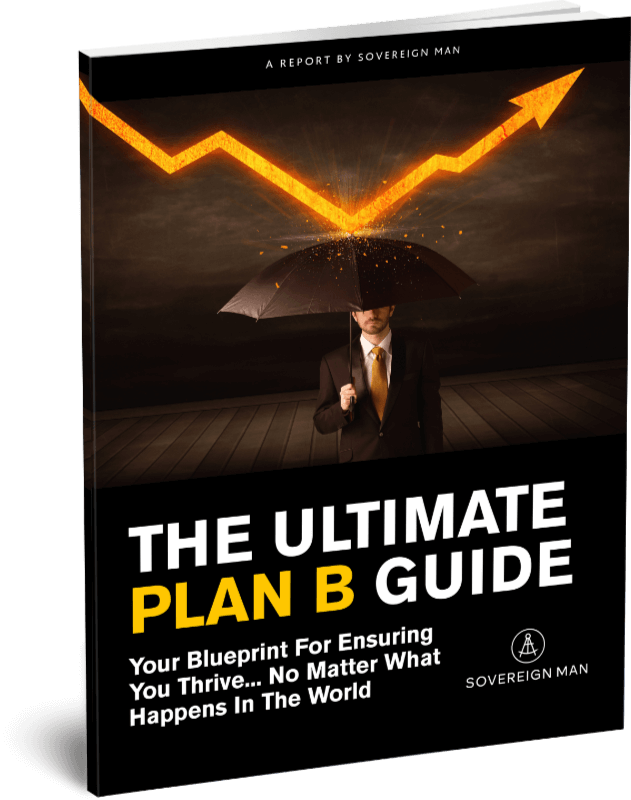
You’ll also learn many other useful strategies such as how to generate strong investment returns while taking minimal risk, and how to obtain a valuable second passport.
We’re not certified investment professionals, so consider the following for informational purposes only, not as investment advice.
Since the early 1980s, interest rates have gradually trended down.
And although there were some brief periods of inflation, generally, prices have been stable.
But we don’t imagine that the next 40 years will resemble the last 40 years. And you should prepare for the possibility that the economic landscape will vastly change.
Moving forward, the traditional 60/40 investment portfolio — 60% of your money in stocks, 40% in bonds, a standard allocation — may not be the best way to prepare for an inflationary environment.
If interest rates on 10-year Treasury notes and 30-year Treasury bonds were to rise, despite the Fed frantically buying these securities to suppress rates, then your bond portfolio would plummet in value.
(The price of bonds moves inversely to the yield.)
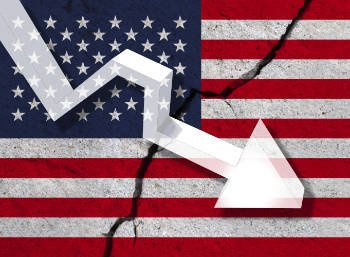
Simultaneously, if inflation were to get out of hand, then your equities may also plummet in value. Businesses would face higher input costs. Borrowing costs would also increase. Without access to cheap capital, many companies’ margins would be squeezed.
But not all businesses would suffer. In fact, select companies may thrive, no matter what’s ahead…
In inflationary times, what many think of as a “great business” could shift.
Take today’s overhyped, overvalued tech companies, for example.
When interest rates and inflation are low, analysts and investors might ignore these companies’ pitiful earnings. What often matters most is the “growth” narrative — even if it will never actually come true. Regardless, these types of companies can get branded as a “great business.”
Our definition of a great business is quite different. And it doesn’t shift with the changing economic tide.
Whether a publicly-traded or private business, the first key vital ingredient to success is management.
Here’s a list of questions to ask yourself about the management team:

If any of your answers is no, then it should be a pass.
Besides management, consider if the business has pricing power. Pricing power gives the company options. And options ultimately give you greater control of your investment.
In inflationary times, a great business with pricing power can control its costs and consolidate market share. Or, in other words, management can tame inflation internally in the business and use inflation to its benefit to generate more revenue. The business actually gets a boost from inflation.
And if inflation runs its course and deflation returns, then a great business has you covered, too. In a deflationary environment, cash is king because its value increases. Any great business throws off plenty of cash to its investors.
Whatever business you’re considering as an investment, we always encourage you to perform thorough due diligence. And speak with your financial advisor.
Again, we’re not advisors, and you should not take this as investment advice. But we’ll conclude this section with some examples of businesses that might help you weather inflation:
Finally, don’t adopt a scarcity mindset. Investment opportunities in great businesses could exist all around you.
For example, maybe you know a local, master carpenter who makes one-of-a-kind furniture pieces. And he’s seeking investors to expand his business. Even with the price of raw materials rising, this business is unaffected, because he has a cult following. This means he can pass along the price increase to customers, who won’t balk at it.
Keep your eyes open and hunt for investment opportunities like these, and you never know what you may find. And, as a nice complement to a great business, there’s another asset class you can consider to combat inflation…
In August 2020, gold hit an all-time high of $2,058 per ounce.
Since then, it’s trended down.
That pullback was a shock to some precious metals investors. But not to us.
Two days prior to that record high of $2,058 per ounce, we wrote that “a short-term correction” in gold prices might occur, especially “if a COVID vaccine is produced.” And that’s precisely what happened.
As we write, gold is nowhere near that all-time high mark.
Silver has fared even worse. It’s down nearly 50% from its all-time high of $50, which occured back in April 2011.
But frankly, the fact that gold and silver are undervalued and overlooked is what makes these assets even more attractive.
Sure, the metals’ short-term price movement warrants some discussion.
But our primary focus is elsewhere, and much more long-term. We view physical precious metals as an insurance policy against out-of-control central banks, governments and the financial chaos they could potentially unleash.

Insurance is there for the “just in case” moments. You don’t ever want to use your home insurance or car insurance policies.
The same concept applies to physical gold and silver.
But if conditions go awry, you’ve got an asset in your possession with a 5,000-year history of value and marketability.
So, if you’re concerned about perpetual money printing and coming inflation, consider buying and holding physical precious metals — the original inflation hedge.
Cryptocurrencies: The digital inflation hedge
At Sovereign Research, we’re not fanatics for precious metals or cryptocurrencies.
We don’t take sides in the battle. Instead, if you’ve made it to the point that you’re considering inflation hedges, why not consider expanding your arsenal? In other words, there’s no need to approach precious metals and cryptocurrencies as an either/or proposition.
We won’t detail the “perfect” allocation between the two — because there’s no such thing.
You’ll need to carefully weigh the reasons for holding precious metals — millennia of wealth preservation — with the reasons for holding cryptocurrencies — a nascent asset with big potential upside.
And then speak with your financial advisor about what’s best for you.
Back in May 2020, in our Monthly Letter for paid subscribers, we looked ahead and outlined five potential economic scenarios.
One scenario was a repeat of the post-2008 cycle, in which we saw:
Plummeting asset and consumer prices -> Bankrupt businesses -> Massive monetary injections -> Rising retail prices (without a commensurate wage increase) -> And finally, asset price increases (including oil soaring to well over $100 per barrel).
That path sounds familiar to the one we’re on today. Inflation has finally made it into the news cycle.
But there’s still largely a belief that inflation is “transitory” — as the Fed often is repeatedly pointing out.
We’re not in that camp. Fed officials don’t exactly have a pristine forecasting track record.
For example, back in July 2005, then Chairman of George W. Bush’s Council of Economic Advisors and future Fed Chair, Ben Bernanke, spoke about housing prices (emphasis ours):
“We’ve never had a decline in house prices on a nationwide basis. So, what I think is more likely is that house prices will slow, maybe stabilize, might slow consumption spending a bit. I don’t think it’s gonna drive the economy too far from its full employment path, though.”
Just three years later, the US suffered the worst economic crisis since the Great Depression… because of collapsing home prices and the associated financial derivatives. To prop up the economy, the Fed and other central banks promptly flooded the world with money.
And over the last decade, the Fed largely hasn’t stopped expanding its balance sheet. Since March 2020, the Fed’s money printing has gone into hyperdrive.
Simultaneously, the US federal government continues to spend. Production has been curtailed. Businesses continue to suffer under stringent operating rules.
Too much money relative to the amount of stuff in the economy inevitably leads to higher inflation.
We have a plan for inflation.
Do you?
Take Back Control Of Your Retirement Savings Today.
Don’t let the stock market hold your retirement savings hostage – discover two powerful tools to help you take back control and invest in REAL assets in 2022!
In this report…
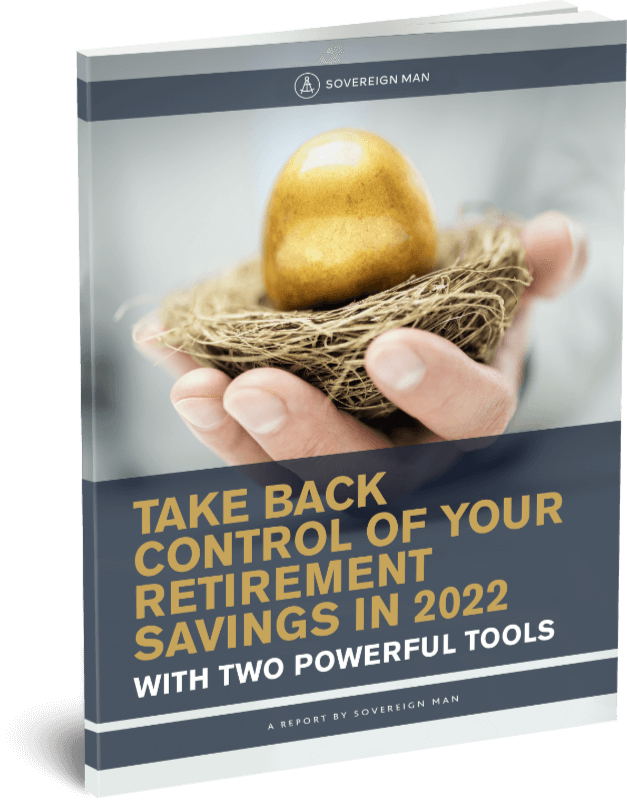
Legal Disclaimer:
Neither this document, nor any content presented by our organization, is intended to provide personal tax or financial advice. This information is intended to be used and must be used for information purposes only.
We are not investment or tax advisors, and this should not be considered advice. It is very important to do your own analysis before making any investment or employing any tax strategy. You should consider your own personal circumstances and speak with professional advisors before making any investment.
The information contained in this report is based on our own research, opinions, as well as representations made by company management. We believe the information presented in this report to be true and accurate at the time of publication but do not guarantee the accuracy of every statement, nor guarantee that the information will not change in the future.
It is important that you independently research any information that you wish to rely upon, whether for the purpose of making an investment or tax decision, or otherwise.
No content on the website (SovereignMan.com) or related sites, nor any content in this email, report, or related content, constitutes, nor should be understood as constituting, a recommendation to enter into any securities transactions or to engage in any of the investment strategies presented here, nor an offer of securities.
Sovereign Man employees, officers, and directors may participate in any investment described in this content when legally permissible, and do so on the same investment terms as subscribers. Sovereign Man employees, officers, or directors receive NO financial compensation from companies who appear in this report.
Join over 100,000 subscribers who receive our free Notes From the Field newsletter
where you’ll get real boots on the ground intelligence as we travel the world and seek out the best opportunities for our readers.
It’s free, it’s packed with information, and best of all, it’s short… there’s no verbose pontification here– we both have better things to do with our time.
And while I appreciate all the visitors who stop by our website, I provide special bonuses to our email subscribers… including free premium intelligence reports and other valuable content that I only share with them.
It’s definitely worth your while to sign-up, and if you don’t like it, you can unsubscribe at any time.
How did you like this article?
Click one of the stars to add your vote...
Other readers gave this article an average rating of 5 stars.